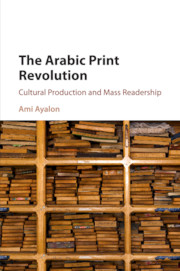Book contents
- Frontmatter
- Dedication
- Contents
- Preface and Acknowledgments
- Introduction
- 1 The Formative Phase of Arab Printing: A Historical Overview
- 2 Printers and Publishers
- 3 Books, Journals, Cartes de visite
- 4 Diffusion Channels
- 5 Advancing Circulation
- 6 Reading and Readers
- 7 Reading in Public
- Conclusion
- Bibliography
- Index
7 - Reading in Public
Published online by Cambridge University Press: 05 September 2016
- Frontmatter
- Dedication
- Contents
- Preface and Acknowledgments
- Introduction
- 1 The Formative Phase of Arab Printing: A Historical Overview
- 2 Printers and Publishers
- 3 Books, Journals, Cartes de visite
- 4 Diffusion Channels
- 5 Advancing Circulation
- 6 Reading and Readers
- 7 Reading in Public
- Conclusion
- Bibliography
- Index
Summary
One noticeable change in popular reading habits which the entry of printing triggered was extending the practice on a big scale into the public domain, outside the privacy of one's home or the quiet of the library. Reading in public places, both silently and aloud, was not new in the Middle Eastern experience. But its extensive dimensions were, as were some social routines that came with it. By the eve of World War I, people reading in public locations were becoming a common sight in many parts of the region. It was seen mostly in urban areas but gradually also in rural ones. The practice had two main forms: individual and silent, of literate people (predominantly men) reading quietly to themselves; and collective-vocal, involving both literate and illiterate people going through a text in groups. Both forms resulted from the expanding availability of printed items and the rising public inquisitiveness about their contents. But each of the two forms had its own course and logic. They will be examined here separately for their cultural significance.
Self-Reading in Public: Café Reading
The growing ubiquity of printed texts drew people to reach out for them wherever they could be found out of the home, especially where they could be accessed free of charge. Library and public reading-room shelves were filling with new books that allured scholars, students, and other curious people; and newspapers, obtainable in public places, attracted everybody with their pertinent and practical contents.
A Khedivial Library operational report prepared in 1888, that is, nearly two decades after the library's inauguration, indicated that during the entire previous year the library had served a total of 331 users. This means six to seven readers per week on average, a rather modest pace. This rate increased in later years, reaching a total of 2,582 in 1903 and 3,331 in 1904, by another account. The last figure suggests a weekly average of roughly sixty-five users, a significant growth over the few of a decade and a half earlier. Some of these visitors must have been scholars, who came to consult works in the collection as members of their ranks had done in the past.
- Type
- Chapter
- Information
- The Arabic Print RevolutionCultural Production and Mass Readership, pp. 177 - 193Publisher: Cambridge University PressPrint publication year: 2016



